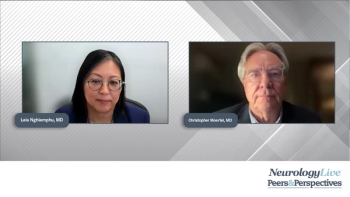
Paraneoplastic Neurologic Syndromes Present Before Testicular Germ Cell Tumor Diagnosis, Study Shows
Key Takeaways
- Patients with TGCTs frequently exhibit PNSs before diagnosis, often linked to neural autoantibodies such as KLHL11, LUZP4, and Ma2-IgG.
- Early recognition and treatment of PNSs can mitigate long-term neurological disabilities and improve cancer outcomes.
In a recent study of patients with testicular germ cell tumors, most exhibited paraneoplastic neurologic syndromes proceeding with their cancer diagnosis, often associated with specific neural autoantibodies.
In a newly published retrospective cohort study, findings showed that patients with testicular germ cell tumors (TGCTs) frequently exhibited paraneoplastic neurologic syndromes (PNSs) prior to their cancer diagnosis, which were often associated with specific neural autoantibody biomarkers such as Kelch-like protein 11 (KLHL11), leucine zipper 4 (LUZP4) antibodies, and Ma2-IgG. These results suggest that timely diagnosis and treatment of PNSs may mitigate substantial long-term neurological disabilities and improve cancer outcomes.1
Out of 49 patients (median age, 41.0 years [IQR, 32.5-47.5]) included in the study, most (n = 33) reported experiencing PNS symptoms before being diagnosed with TGCT. Among the patients included in the study, 45 had definite PNS and 4 had probable PNS, as determined by the PNS CARE score. Findings revealed that the most frequently observed symptoms were ataxia (n = 31), diplopia (n = 29), sensorineural hearing loss (n = 22), and vertigo (n = 20).
“This cohort study found that 80% of patients had neurological symptoms before TGCT diagnosis. Thus, recognition of early signs and symptoms of PNS in young and middle-aged patients should alert neurologists not only to test for KLHL11-IgG, LUZP4-IgG, and Ma2-IgG, but also to search for any underlying occult malignant entity, especially TGCTs,” lead author Ehab Harahsheh, MBBS, assistant professor of neurology at the University of Arizona, and colleagues wrote.1 “Early recognition and diagnosis of PNS in patients with TGCT by oncologists via testing for these antibodies may reduce long-term neurological dysfunction, a major cause of morbidity and mortality in our cohort, especially with the favorable TGCT outcomes.”
For the current study, researchers aimed to investigate the oncological, neurological, and serological profiles of patients with TGCT and PNS. Authors noted that the analysis included patients aged 18 years or older with histopathologically confirmed diagnosis of TGCT, or regressed TGCT, and PNS. These patients completed evaluation and treatment at
Most TGCT cases were seminomas (n = 33), with the remainder (n = 9) consisting of NSGCT or regressed TGCTs (n = 7). Notably, results showed that seminomas were more often associated with ataxia, sensorineural hearing loss, and vertigo, whereas nonseminomatous germ cell tumors (NSGCTs) were more frequently associated with seizures and sleep disturbances.
Over a median follow-up of 33.0 months (IQR, 6.5-64.0) from TGCT diagnosis to final evaluation, 80% of patients achieved either cure (n = 18) or remission (n = 21), while 6 patients experienced tumor relapses (12%), and 9 patients died (18%). Authors noted that no deaths were attributed to TGCTs; 6 patients died of PNS, 1 died of myocardial infarction, and the cause of death was unclear for 2 patients.
All told, 94% of patients tested positive for neural autoantibodies. The most frequently identified antibody was KLHL11-IgG (n = 32), including 20 cases alone and 12 cases coexisting with LUZP4-IgG, followed by Ma2-IgG (n = 9), including 1 case coexisting with LUZP4-IgG, and LUZP4-IgG alone (n = 5). Among patients with KLHL11-IgG and LUZP4-IgG, seminomas were present in 72% (n = 23) and 78% (n = 14), respectively. In contrast, 78% of patients with Ma2-IgG (n = 7) had NSGCTs. Furthermore, KLHL11-IgG and Ma2-IgG were associated with seminomas (OR, 8.06; 95% CI, 1.42-45.46; P = .02) and NSGCTs (OR, 54.25; 95% CI, 6.48-454.07; P <.001), respectively.
Additional findings demonstrated that KLHL11-IgG was associated with sensorineural hearing loss (OR, 12.50; 95% CI, 2.43-64.43; P <.001) and tinnitus (OR, 12.44; 95% CI, 1.47-105.52; P = .006), whereas Ma2-IgG was associated with seizures (OR, 11.33; 95% CI, 2.21-58.15; P = .004) and sleep disturbances (OR, 43.17; 95% CI, 6.06-307.41; P <.001). Moreover, only 8 patients showed improvement of their PNS (16%), whereas 21 had stabilization (43%) and 20 had progression (41%), despite immunomodulatory treatment.
“The type of neurological manifestation and neural antibodies varied according to the TGCT subtype. Thus, the presence of neurological manifestations and neural antibodies may not only indicate an underlying occult TGCT but could also suggest the tumor histology. Potential study limitations include selection bias and referral bias. Although most patients achieved positive cancer outcomes, many faced long-term neurological disability,” Harahsheh et al noted.1
At the
REFERENCES
1. Harahsheh E, Hammami MB, Gupta P, et al. Testicular Cancer-Associated Paraneoplastic Neurologic Syndromes. JAMA Netw Open. 2025;8(10):e2538584. Published 2025 Oct 1. doi:10.1001/jamanetworkopen.2025.38584
Newsletter
Keep your finger on the pulse of neurology—subscribe to NeurologyLive for expert interviews, new data, and breakthrough treatment updates.






























